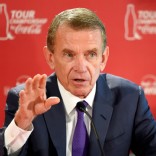As the Walker Cup looms this weekend riding on almost no wave of attention, the reasons are pretty obvious:
 -- A small TV presence (the ESPN details are in my Forward Press column), few star amateurs sticking around
-- A small TV presence (the ESPN details are in my Forward Press column), few star amateurs sticking around
-- Players selected choosing college events over the Cup
-- A secretive selection process that engenders no awareness of the competition to make the team or the rationale for why the USA team was picked
-- A trip to a links that isn't the more interesting links the R&A could go to for this event
Matters this week weren't helped with the news that Sam Horsfield, who was the fourth-highest GB&I player on the team before withdrawing for "personal reasons," just played five qualifying rounds and is on for Florida's first travel squad of the fall.
Alistair Tait at Golfweek reports.
Horsfield did not answer Golfweek’s requests for an interview. However, Florida head coach J.C. Deacon responded by email to Golfweek’s question on why Horsfield could not play at Royal Lytham and St. Annes but could tee it up at the Carpet Capital.
Deacon wrote: “Sam would have loved to be overseas playing for GB&I but a family situation came up. He was ready to play and excited to represent his country, so I truly feel for him. He's an amazing young man and we are all supporting him. It's a personal issue within Sam's family and I wouldn't feel right commenting further. I appreciate you understanding and having Sam's best interest at heart.”
Therefore, it may be time to reconsider elements to what should be a sensational and historic event.
Adam Schupak pens a Golfweek.com column making suggestions about how to improve the event. The only one within the reach of the USGA and R&A involves the date, which is proving problematic for elite college players wanting to turn pro. I'm not sure a move to spring would help either though...
The Walker Cup’s September date, which is during the school year for most of these college-aged players, seems antiquated. Sure, a May date would take some of the luster off the amateur summer, but winning the U.S. Amateur would be just as prestigious, and it doesn’t seem as though the hot hand gets picked for the team anyway (See Aaron Wise, winner of the Pacific Coast Amateur, runner-up in the Western Amateur; Derek Bard, finalist in the U.S. Amateur).
Why does having the best players represented matter, you ask? This has long been an event that elite amateur golfers from the U.S. and GB&I aspire to be part of before they turn pro. Hall termed it “a bucket list item in an amateur career.” It should remain that way. But don’t just take my word for it. Patrick Rodgers represented the American side in the previous two Walker Cups.
“I wish more people had the experience I had playing in two Walker Cups,” he said. “Not only is it the pinnacle of amateur golf, it may be the most fun you ever have playing golf. I wouldn’t pass up that experience for any kind of money playing professional golf. I think kids who skip out on that opportunity are making a big mistake, to be honest.”
The 2017 Walker Cup returns to the United States and will be played at The Los Angeles Country Club.
 Whether due to golfers being morning people, or the days at major championships just going on too long, it’s become a strange late-day sight to see sparse crowds.
Whether due to golfers being morning people, or the days at major championships just going on too long, it’s become a strange late-day sight to see sparse crowds.












